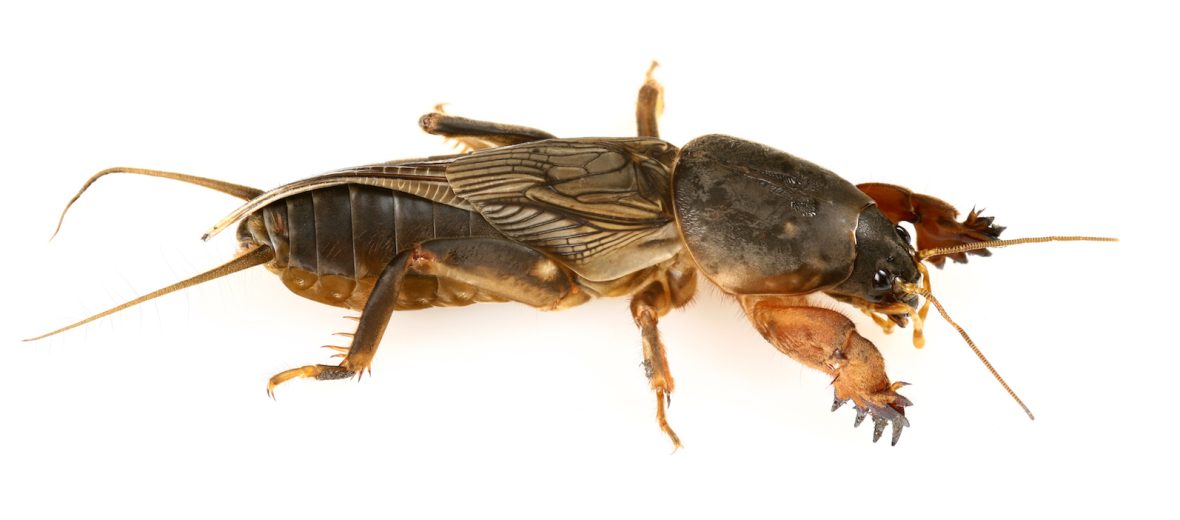
The mole cricket is part of the order Orthoptera, which includes grasshoppers and crickets. These critters can be found on every continent, sans Antarctica. They are considered a pest species of insect and are treated as such, via pesticides. Due to stable, yet decreasing, populations and worldwide distribution they are listed as Least Concern by the IUCN. They face the threats of agricultural and aquacultural demands; pollution; habitat destruction; and extermination.
First the Stats…
Scientific name: Gryllotalpa gryllotalpa
Length: Up to 1.4+ inches
Lifespan: Up to 3 years
Now on to the Facts!
1.) Some species of mole crickets are herbivores (consume plant matter) that primarily feed on roots; others are omnivores (consume plant and animal matter) and feed on worms and grubs; and a few are predatory.
2.) Males have a very loud song that they produce from within their burrow to attract a mate.
3.) Mole crickets are fossorial (spend most of their lives underground).
4.) In an example of convergent evolution, these crickets have evolved large, strong forelimbs that are used for digging.
5.) Adult mole crickets have the ability to fly quite well, but prefer to only do so when looking for a mate.
But wait, there’s more on the mole cricket!
6.) The mole cricket undergoes up to 10 molts before reaching the adult phase.
7.) Females lay up to 60 eggs.
Did you know…?
In Zambia, mole crickets are believed to bring good fortune. In Latin America, they are said to predict rain. However, in the united States, where Neoscapteriscus mole crickets are not native, they are considered to be a pest species.
8.) Male mole crickets sing via stridulation (scraping the rear edge of the left fore wing, which forms a plectrum, against the lower surface of the right fore wing, which has a ratchet-like series of asymmetrical teeth), and it is always done underground.
9.) The male’s song is an almost pure tone at 3.5 kHz (or 92 decibels), which is loud enough to make the ground vibrate 7.87 inches all round the burrow. Their song is unique in each species.
10.) The loudest males can attract up to 20 females in 1 evening. Quieter males might not attract any at all.
But wait, there’s still more on the mole cricket!
11.) Birds, insectivorous mammals, toads, assassin bugs, wolf spiders, and various beetles all prey on mole crickets.
12.) The Brazilian red-eyed fly is a parasitoid species that lays 1 or more eggs on any mole cricket it can find. The egg(s) hatch and the larvae goes to work burrowing into the abdomen of the mole cricket, consuming it from the inside out. These flies are attracted by the singing of the male(s).
Did you know…?
Mole crickets have sometimes been used as human food in West Java and Vietnam.
13.) The first-detected invasive mole cricket species was Neoscapteriscus didactylus, which is a South American species reported as a pest. To control these pests, a parasitoid wasp, Larra bicolor, from Amazonian Brazil was introduced and actually succeeded in controlling the spread of mole crickets.
14.) A project that became known as the UF/IFAS Mole Cricket Research Program was initiated in 1978. This project reported, in 2006, a summary publication that announced the following success: a 95% reduction in mole cricket numbers in northern Florida alone.
15.) The damage caused by mole crickets results in root damage, and soil dehydration.
Now a Short Mole Cricket Video!
Be sure to share & comment below! Also, check out the Critter Science YouTube channel. Videos added regularly!
Want to suggest a critter for me to write about? Let me know here.



